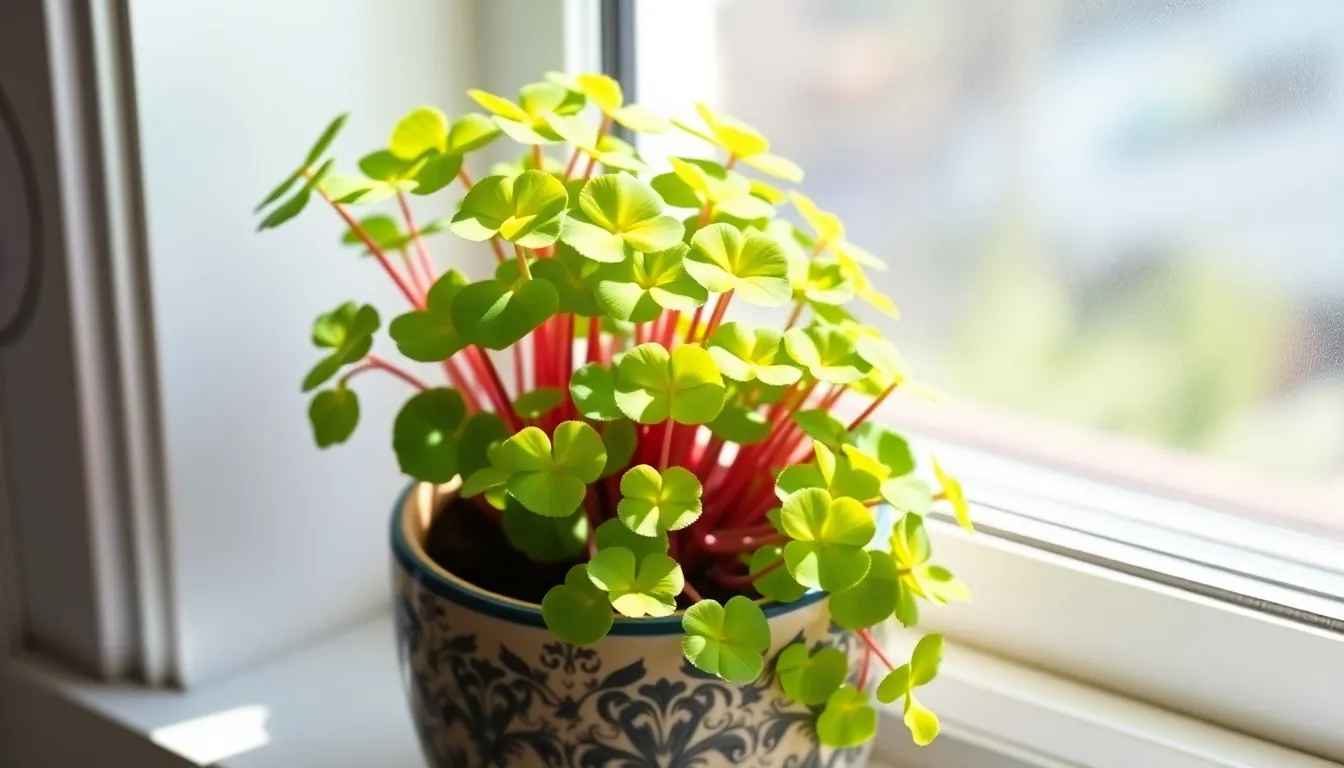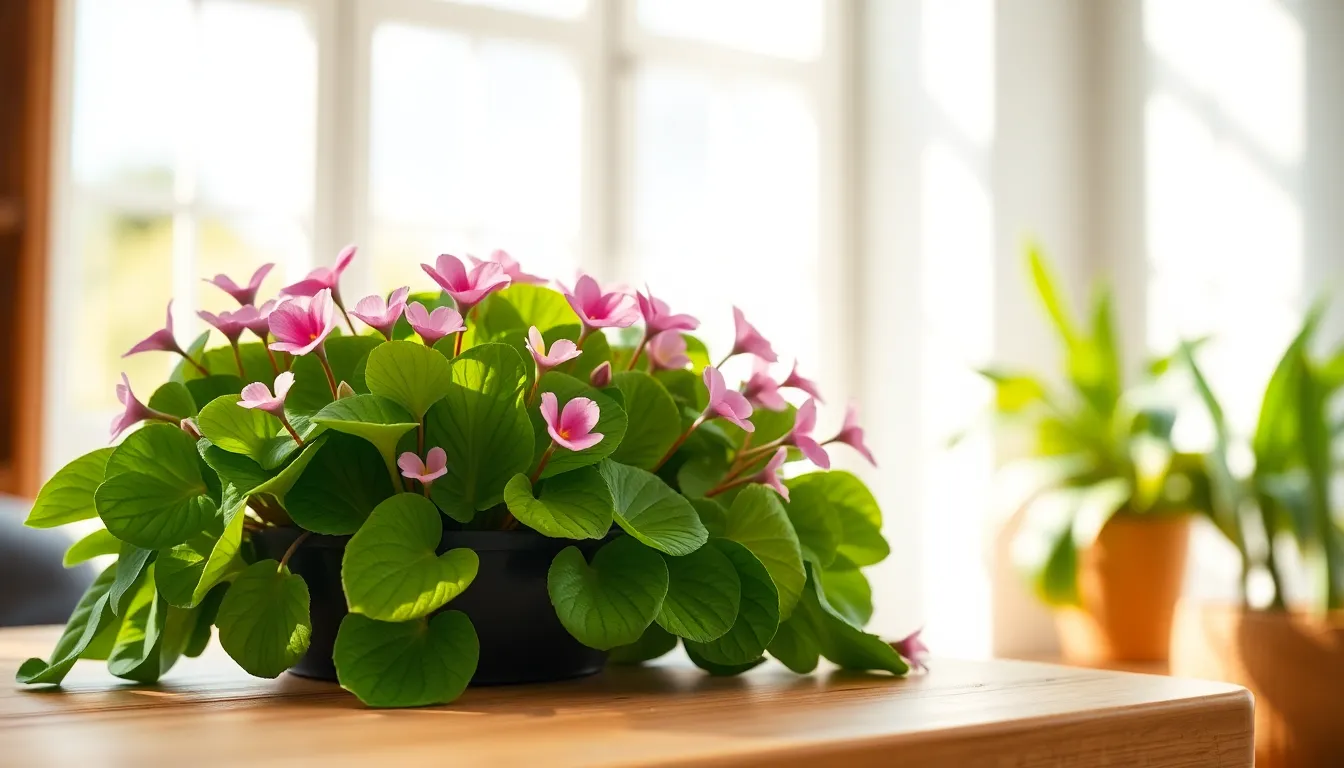If you’re looking to add a touch of charm to your home or garden, the oxalis plant might just be your new best friend. With its vibrant green leaves and delicate flowers, this little beauty is not only a feast for the eyes but also surprisingly easy to care for. Think of it as the low-maintenance roommate who always brings snacks to the party—no fuss, just good vibes.
Oxalis Plant Care
Oxalis plants, commonly known as wood sorrels, belong to a vast genus comprising over 500 species. This diverse range includes varieties that exhibit different leaf shapes and colors, from green to purplish hues. Small, often clover-like leaves set off charming flowers that may appear in shades of white, yellow, or pink, enhancing garden aesthetics.
Native to various regions across the globe, oxalis thrives in both indoor and outdoor settings. Many gardeners appreciate its ability to adapt to different lighting conditions, from bright direct sunlight to partial shade. Preferably, the plant enjoys well-draining soil that maintains some moisture without becoming waterlogged.
Growing oxalis requires minimal effort. Regular watering ensures that the soil remains slightly moist, especially during the growing season. Allowing the plant to dry out slightly between waterings promotes healthier root development. Fertilization with a balanced, all-purpose fertilizer every four to six weeks encourages vibrant growth and blooming.
In terms of pest resistance, oxalis is generally robust, but occasional aphids or spider mites may appear. Monitoring for these pests and treating with insecticidal soap or neem oil can help manage infestations effectively.
Providing the correct environment leads to thriving oxalis plants. Observing leaf shape and blooming patterns can guide care adjustments. Home gardeners often find that a little attention results in a lively and attractive plant that adds charm to any space.
Basic Requirements For Oxalis Plant Care

Oxalis plants thrive with straightforward care practices. Understanding their specific needs ensures vibrant growth.
Light Conditions
Oxalis prefers bright, indirect light. Placing it near a window provides optimal conditions. Direct sunlight can scorch the leaves, so filtered light is ideal. While some species tolerate lower light, growth may slow down. Observing the plant’s response helps adjust its placement accordingly.
Soil Type
A well-draining soil mix benefits oxalis growth. Combining potting soil with perlite or sand enhances drainage. Soil should remain slightly acidic to neutral, ensuring nutrient availability. Oxalis can suffer in heavy soils that retain too much moisture. Regularly checking soil texture assists in achieving the right balance.
Watering Needs
Slightly moist soil keeps oxalis healthy. Watering when the top inch of soil feels dry prevents over-saturation. It’s essential to avoid letting the plant sit in standing water. During dormancy, reduce watering frequency, allowing the soil to dry out more. Observing leaf color and texture indicates the plant’s hydration level.
Fertilizing Oxalis Plants
Fertilizing oxalis plants is essential for promoting healthy growth and vibrant blooms. Using the right fertilizers supports their natural vigor.
Types Of Fertilizers
Balanced fertilizers work best for oxalis plants. Opt for options with equal parts nitrogen, phosphorus, and potassium, like a 10-10-10 blend. Liquid fertilizers also provide quick nutrients. Granular forms offer longer-lasting effects. Organic fertilizers, such as worm castings or fish emulsion, enhance soil quality and promote healthy root systems. Both types contribute to overall plant health while being gentle on the soil.
Frequency Of Fertilization
Fertilization frequency impacts oxalis growth. Applying fertilizer every 4 to 6 weeks during the growing season is ideal. Reduce applications during dormancy, typically in winter. Monitoring the plant’s health can indicate nutrient needs. Adjust frequency based on growth patterns and environmental conditions. Maintaining a consistent fertilizing schedule ensures lush foliage and abundant flowers.
Common Problems And Solutions
Oxalis plants may encounter a few issues, but most are manageable with prompt attention.
Pests And Diseases
Aphids and spider mites can appear on oxalis plants, causing significant damage to leaves. He should inspect the leaves regularly to spot these pests early. When infestations occur, a gentle spray of insecticidal soap usually suffices to eliminate them. Fungal infections can develop in overly moist conditions, leading to leaf spots. To combat this, ensure good air circulation and avoid water on the leaves during watering.
Leaf Discoloration
Leaves may turn yellow due to several factors, with overwatering often being the primary culprit. When yellowing occurs, assess the moisture level of the soil. A shift in light exposure can also lead to discoloration; too much direct sunlight can scorch the leaves. If the plant appears leggy with pale leaves, insufficient light might be a problem. Adjusting the light conditions often promotes healthy leaf color, restoring vibrancy in no time.
Propagation Methods For Oxalis
Propagation for oxalis plants can occur through several methods, ensuring gardeners can expand their collections easily. Without special tools, one effective technique involves dividing the bulbs. During active growth, carefully remove the plant from its pot. Separate the bulbs, ensuring each has roots attached. Replant individually in well-draining soil, maintaining slight moisture.
Another popular method is stem cuttings. Select healthy stems, about 3 to 4 inches long, and cut just below a node. Place the cuttings in a container filled with water or moist soil, ensuring they receive indirect light. Roots typically develop within a few weeks. Change the water regularly to prevent stagnation when using water propagation.
Seeds also offer a way to propagate oxalis. Collect seeds from mature flowers once they have dried. Plant them in seed-starting mix and cover lightly with soil. Keep the mix damp but not soggy, and provide warm temperatures for germination. Sprouts may appear within 15 to 30 days, depending on species.
Additionally, offsets can form around established plants. When the parent plant produces new bulbs, these can be gently removed and replanted. Offsets often root quickly, contributing to a flourishing garden. Careful handling ensures minimal damage to both parent and offspring plants.
Each propagation method serves to enhance a gardener’s collection and create more vibrant displays. Observing the specific needs of each oxalis species can yield better results, ensuring flourishing plants in any setting.
Conclusion
Caring for oxalis plants is a rewarding experience that brings beauty and charm to any space. With their vibrant foliage and delicate blooms they require minimal effort to thrive. By providing the right light conditions and maintaining proper moisture levels gardeners can enjoy lush growth and colorful displays.
Regular monitoring for pests and adjusting care as needed ensures that these resilient plants remain healthy. Additionally the various propagation methods offer opportunities to expand one’s collection effortlessly. Embracing oxalis in home or garden decor not only enhances aesthetics but also fosters a connection with nature.

